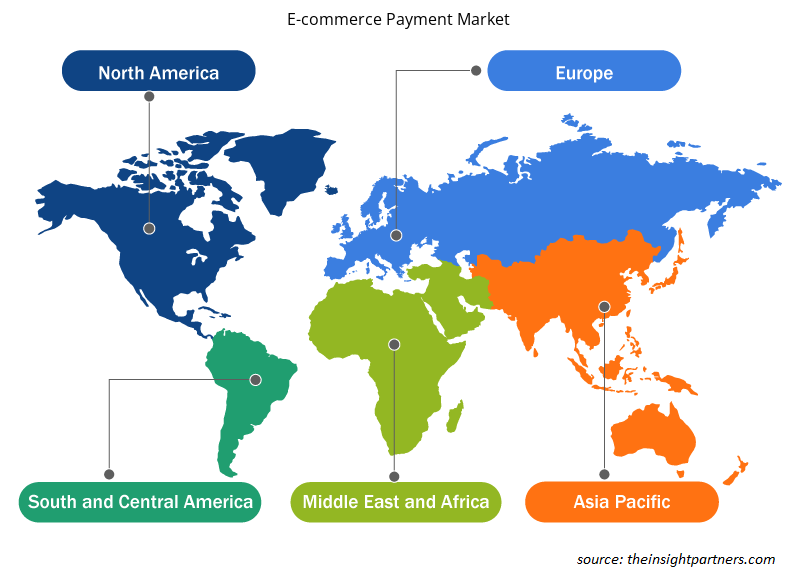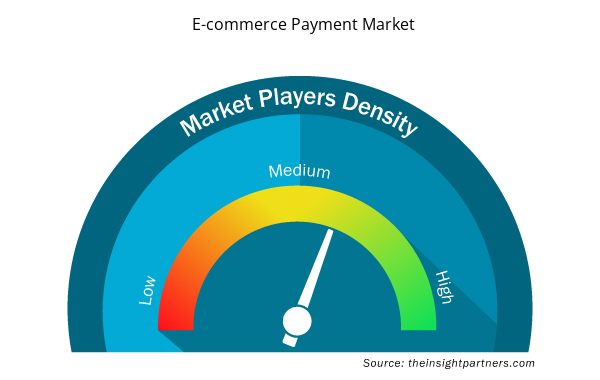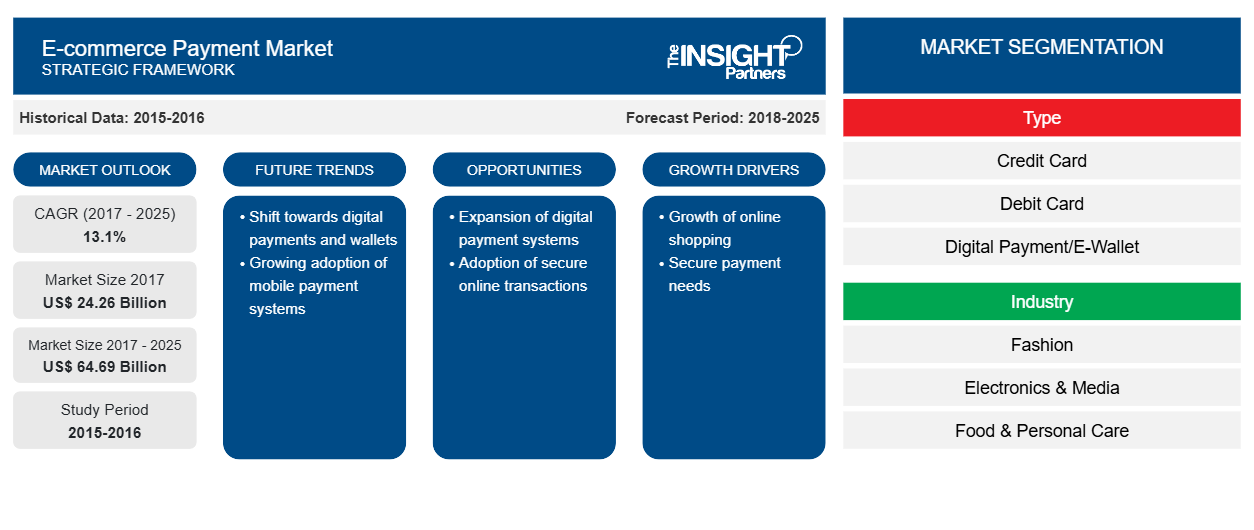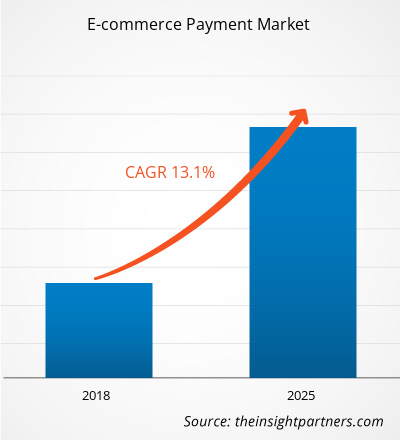من المتوقع أن ينمو سوق الدفع للتجارة الإلكترونية العالمية من 24.26 مليار دولار أمريكي في عام 2017 إلى 64.69 مليار دولار أمريكي بحلول عام 2025 بمعدل نمو سنوي مركب قدره 13.1٪ بين عامي 2018 و 2025.
يشهد سوق الدفع للتجارة الإلكترونية نموًا في جميع أنحاء العالم، مع تفضيل متزايد لإجراء المدفوعات عبر الإنترنت بسبب توافر العديد من طرق الدفع. علاوة على ذلك، فإن التبني المتزايد للهواتف الذكية وتوافر الإنترنت يدفع أيضًا نمو سوق الدفع للتجارة الإلكترونية. علاوة على ذلك، من المتوقع أن يزدهر سوق الدفع للتجارة الإلكترونية خلال الفترة المتوقعة مع زيادة عدد السكان المصرفيين والرقمنة. يركز التقرير على تقسيم متعمق لسوق الدفع للتجارة الإلكترونية بناءً على النوع والقطاع الرأسي الصناعي والجغرافيا.
رؤى السوق
تم التعرف على منطقة آسيا والمحيط الهادئ باعتبارها المنطقة الرائدة طوال فترة التوقعات
تتكون منطقة آسيا والمحيط الهادئ من العديد من البلدان النامية مثل كوريا الجنوبية والهند وإندونيسيا وماليزيا وغيرها. تشهد هذه البلدان نموًا كبيرًا في عدد سكانها، مما يؤدي إلى نمو سوق الدفع عبر التجارة الإلكترونية. تزدهر صناعة التجارة الإلكترونية في المنطقة مع زيادة انتشار الإنترنت بالإضافة إلى التبني العالي للهواتف الذكية والأجهزة اللوحية. كما تتخذ حكومات الاقتصادات الناشئة مبادرات لتحسين عدد السكان المصرفيين وبالتالي توفير منصة أفضل لصناعة الدفع عبر الإنترنت. في الآونة الأخيرة، لوحظ تحول حيث يفضل المستهلكون في جميع أنحاء منطقة آسيا والمحيط الهادئ الدفع عبر الإنترنت من خلال طرق دفع بديلة مثل المحافظ الإلكترونية والتحويلات المصرفية وبطاقات الائتمان والخصم. ومن المتوقع أن يساهم الاستخدام المتزايد لطرق الدفع هذه بشكل كبير في نمو بوابات الدفع في صناعة التجارة الإلكترونية خلال فترة التنبؤ. ومن المتوقع أن تعمل هذه العوامل على دفع الطلب على سوق الدفع عبر التجارة الإلكترونية في منطقة آسيا والمحيط الهادئ.
قم بتخصيص هذا التقرير ليناسب متطلباتك
ستحصل على تخصيص لأي تقرير - مجانًا - بما في ذلك أجزاء من هذا التقرير، أو تحليل على مستوى الدولة، وحزمة بيانات Excel، بالإضافة إلى الاستفادة من العروض والخصومات الرائعة للشركات الناشئة والجامعات
- احصل على أهم اتجاهات السوق الرئيسية لهذا التقرير.ستتضمن هذه العينة المجانية تحليلاً للبيانات، بدءًا من اتجاهات السوق وحتى التقديرات والتوقعات.
لا يزال نموذج الأعمال في قطاع التجزئة غير مستغل في منطقة الشرق الأوسط، مما يوفر إمكانات هائلة للاعبين في الصناعة
إن المدفوعات الرقمية في الشرق الأوسط وصلت إلى نقطة تحول حيث تشهد اللوائح والثقافة والتكنولوجيا تحولات نموذجية، مما يفتح الباب أمام الشركات المبتكرة لتعطيل أقدم أنظمة الدفع. لا يزال أكثر من 80٪ من مدفوعات التجزئة التقليدية و 65٪ من مدفوعات التجارة الإلكترونية تتم نقدًا، ويتجاوز اعتماد الهواتف الذكية 100٪ في العديد من البلدان. إن انتشار الهاتف المحمول في منطقة الشرق الأوسط وأفريقيا على وشك عصر جديد مدفوع بسلوك المستهلك المتطور والتصنيع السريع وطموحات الحكومة والظروف الاقتصادية المتغيرة. تم تحديد الفرص في النمو في الوصول إلى البيانات والإيرادات، والتي أصبحت كبيرة وتنمو بقوة؛ وكذلك في خدمات الدفع الرقمية. يتم التحقق من صحة ذلك من خلال حقيقة أن انتشار الهواتف الذكية في المنطقة أكبر من 65٪. بالإضافة إلى ذلك، يستخدم أكثر من ثلثي السكان الإنترنت، حيث يتجاوز الانتشار في الإمارات العربية المتحدة وقطر 90٪. تضم المنطقة عددًا كبيرًا من الأفراد الأثرياء الذين لديهم شهية للسلع الفاخرة.
لوحظت مبادرة السوق باعتبارها الاستراتيجية الأكثر اعتماداً في سوق الدفع للتجارة الإلكترونية العالمية. وفيما يلي قائمة ببعض الاستراتيجيات الحديثة التي تبناها بعض اللاعبين في سوق الدفع للتجارة الإلكترونية:
2018: أعلنت شركة PayPal عن تمديد اتفاقية شراكتها مع eBay. ومن خلال هذه الاتفاقية، تواصل eBay الترويج لبطاقات PayPal الائتمانية وقبولها من خلال منصة السوق.
2018: أعلنت Alipay عن إطلاقها في 20 دولة أوروبية في نهاية هذا العام. ووقعت الشركة عقودًا مع أكثر من 40 شركة محافظ رقمية و100 بنك في جميع أنحاء أوروبا.
2018: أعلنت شركة Visa، Inc. عن تمديد شراكتها مع PayPal إلى كندا، لتسريع تنفيذ المدفوعات الرقمية والمحمولة الموثوقة والآمنة والمناسبة للتجار والمستهلكين.
رؤى إقليمية حول سوق الدفع في التجارة الإلكترونية
لقد قام المحللون في Insight Partners بشرح الاتجاهات والعوامل الإقليمية المؤثرة على سوق الدفع للتجارة الإلكترونية طوال فترة التوقعات بشكل شامل. يناقش هذا القسم أيضًا قطاعات سوق الدفع للتجارة الإلكترونية والجغرافيا في جميع أنحاء أمريكا الشمالية وأوروبا ومنطقة آسيا والمحيط الهادئ والشرق الأوسط وأفريقيا وأمريكا الجنوبية والوسطى.

- احصل على البيانات الإقليمية المحددة لسوق الدفع للتجارة الإلكترونية
نطاق تقرير سوق الدفع في التجارة الإلكترونية
| سمة التقرير | تفاصيل |
|---|---|
| حجم السوق في عام 2017 | 24.26 مليار دولار أمريكي |
| حجم السوق بحلول عام 2025 | 64.69 مليار دولار أمريكي |
| معدل النمو السنوي المركب العالمي (2017 - 2025) | 13.1% |
| البيانات التاريخية | 2015-2016 |
| فترة التنبؤ | 2018-2025 |
| القطاعات المغطاة | حسب النوع
|
| المناطق والدول المغطاة | أمريكا الشمالية
|
| قادة السوق وملفات تعريف الشركات الرئيسية |
|
كثافة اللاعبين في السوق: فهم تأثيرها على ديناميكيات الأعمال
يشهد سوق الدفع عبر التجارة الإلكترونية نموًا سريعًا، مدفوعًا بالطلب المتزايد من جانب المستخدم النهائي بسبب عوامل مثل تفضيلات المستهلكين المتطورة والتقدم التكنولوجي والوعي المتزايد بفوائد المنتج. ومع ارتفاع الطلب، تعمل الشركات على توسيع عروضها والابتكار لتلبية احتياجات المستهلكين والاستفادة من الاتجاهات الناشئة، مما يؤدي إلى زيادة نمو السوق.
تشير كثافة اللاعبين في السوق إلى توزيع الشركات أو المؤسسات العاملة في سوق أو صناعة معينة. وهي تشير إلى عدد المنافسين (اللاعبين في السوق) الموجودين في مساحة سوق معينة نسبة إلى حجمها أو قيمتها السوقية الإجمالية.
الشركات الرئيسية العاملة في سوق الدفع للتجارة الإلكترونية هي:
- شركة باي بال القابضة
- أمازون بايمنتس، المحدودة
- سي سي بيل، ذ.م.م
- شركة وي باي
- علي باي
إخلاء المسؤولية : الشركات المذكورة أعلاه ليست مرتبة بأي ترتيب معين.

- احصل على نظرة عامة على أهم اللاعبين الرئيسيين في سوق الدفع للتجارة الإلكترونية
تقسيم سوق الدفع للتجارة الإلكترونية العالمية
حسب النوع
- بطاقة إئتمان
- بطاقة الخصم
- الدفع الرقمي/ المحفظة الإلكترونية
- الخدمات المصرفية عبر الإنترنت
- بطاقات الهدايا
- آحرون
حسب الصناعة
- موضة
- الالكترونيات والوسائط
- الغذاء والعناية الشخصية
- الأثاث والأجهزة
- صناعة الخدمات
- آحرون
حسب الجغرافيا
أمريكا الشمالية
- نحن
- كندا
- المكسيك
أوروبا
- فرنسا
- ألمانيا
- إيطاليا
- إسبانيا
- المملكة المتحدة
- بقية أوروبا
آسيا والمحيط الهادئ (APAC)
- أستراليا
- الصين
- الهند
- اليابان
- بقية منطقة آسيا والمحيط الهادئ
الشرق الأوسط وأفريقيا
- المملكة العربية السعودية
- الامارات العربية المتحدة
- جنوب أفريقيا
- باقي منطقة الشرق الأوسط وأفريقيا
أمريكا الجنوبية (SAM)
- البرازيل
- بقية سام
نبذة عن الشركة
- شركة باي بال القابضة
- أمازون بايمنتس، المحدودة
- سي سي بيل، ذ.م.م
- شركة وي باي
- علي باي
- فيزا المحدودة
- ماستركارد إنكوربوريتد
- شركة سترايب
- شركة أمريكان إكسبريس
- شركة يونيون باي الدولية المحدودة
- التحليل التاريخي (سنتان)، السنة الأساسية، التوقعات (7 سنوات) مع معدل النمو السنوي المركب
- تحليل PEST و SWOT
- حجم السوق والقيمة / الحجم - عالميًا وإقليميًا وقطريًا
- الصناعة والمنافسة
- مجموعة بيانات Excel


- Airline Ancillary Services Market
- Virtual Production Market
- Sports Technology Market
- Machine Condition Monitoring Market
- Rare Neurological Disease Treatment Market
- Water Pipeline Leak Detection System Market
- Data Annotation Tools Market
- Railway Braking System Market
- Bioremediation Technology and Services Market
- Greens Powder Market

Report Coverage
Revenue forecast, Company Analysis, Industry landscape, Growth factors, and Trends

Segment Covered
This text is related
to segments covered.

Regional Scope
North America, Europe, Asia Pacific, Middle East & Africa, South & Central America

Country Scope
This text is related
to country scope.
Trends and growth analysis reports related to Banking, Financial Services, and Insurance : READ MORE..
The List of Companies
1. PayPal Holdings, Inc.
2. Amazon Payments, Inc.
3. CCBill, LLC
4. WePay Inc.
5. Alipay
6. Visa, Inc.
7. MasterCard Incorporated
8. Stripe Inc.
9. American Express Company
10. UnionPay International Co., Ltd.
The Insight Partners performs research in 4 major stages: Data Collection & Secondary Research, Primary Research, Data Analysis and Data Triangulation & Final Review.
- Data Collection and Secondary Research:
As a market research and consulting firm operating from a decade, we have published and advised several client across the globe. First step for any study will start with an assessment of currently available data and insights from existing reports. Further, historical and current market information is collected from Investor Presentations, Annual Reports, SEC Filings, etc., and other information related to company’s performance and market positioning are gathered from Paid Databases (Factiva, Hoovers, and Reuters) and various other publications available in public domain.
Several associations trade associates, technical forums, institutes, societies and organization are accessed to gain technical as well as market related insights through their publications such as research papers, blogs and press releases related to the studies are referred to get cues about the market. Further, white papers, journals, magazines, and other news articles published in last 3 years are scrutinized and analyzed to understand the current market trends.
- Primary Research:
The primarily interview analysis comprise of data obtained from industry participants interview and answers to survey questions gathered by in-house primary team.
For primary research, interviews are conducted with industry experts/CEOs/Marketing Managers/VPs/Subject Matter Experts from both demand and supply side to get a 360-degree view of the market. The primary team conducts several interviews based on the complexity of the markets to understand the various market trends and dynamics which makes research more credible and precise.
A typical research interview fulfils the following functions:
- Provides first-hand information on the market size, market trends, growth trends, competitive landscape, and outlook
- Validates and strengthens in-house secondary research findings
- Develops the analysis team’s expertise and market understanding
Primary research involves email interactions and telephone interviews for each market, category, segment, and sub-segment across geographies. The participants who typically take part in such a process include, but are not limited to:
- Industry participants: VPs, business development managers, market intelligence managers and national sales managers
- Outside experts: Valuation experts, research analysts and key opinion leaders specializing in the electronics and semiconductor industry.
Below is the breakup of our primary respondents by company, designation, and region:

Once we receive the confirmation from primary research sources or primary respondents, we finalize the base year market estimation and forecast the data as per the macroeconomic and microeconomic factors assessed during data collection.
- Data Analysis:
Once data is validated through both secondary as well as primary respondents, we finalize the market estimations by hypothesis formulation and factor analysis at regional and country level.
- Macro-Economic Factor Analysis:
We analyse macroeconomic indicators such the gross domestic product (GDP), increase in the demand for goods and services across industries, technological advancement, regional economic growth, governmental policies, the influence of COVID-19, PEST analysis, and other aspects. This analysis aids in setting benchmarks for various nations/regions and approximating market splits. Additionally, the general trend of the aforementioned components aid in determining the market's development possibilities.
- Country Level Data:
Various factors that are especially aligned to the country are taken into account to determine the market size for a certain area and country, including the presence of vendors, such as headquarters and offices, the country's GDP, demand patterns, and industry growth. To comprehend the market dynamics for the nation, a number of growth variables, inhibitors, application areas, and current market trends are researched. The aforementioned elements aid in determining the country's overall market's growth potential.
- Company Profile:
The “Table of Contents” is formulated by listing and analyzing more than 25 - 30 companies operating in the market ecosystem across geographies. However, we profile only 10 companies as a standard practice in our syndicate reports. These 10 companies comprise leading, emerging, and regional players. Nonetheless, our analysis is not restricted to the 10 listed companies, we also analyze other companies present in the market to develop a holistic view and understand the prevailing trends. The “Company Profiles” section in the report covers key facts, business description, products & services, financial information, SWOT analysis, and key developments. The financial information presented is extracted from the annual reports and official documents of the publicly listed companies. Upon collecting the information for the sections of respective companies, we verify them via various primary sources and then compile the data in respective company profiles. The company level information helps us in deriving the base number as well as in forecasting the market size.
- Developing Base Number:
Aggregation of sales statistics (2020-2022) and macro-economic factor, and other secondary and primary research insights are utilized to arrive at base number and related market shares for 2022. The data gaps are identified in this step and relevant market data is analyzed, collected from paid primary interviews or databases. On finalizing the base year market size, forecasts are developed on the basis of macro-economic, industry and market growth factors and company level analysis.
- Data Triangulation and Final Review:
The market findings and base year market size calculations are validated from supply as well as demand side. Demand side validations are based on macro-economic factor analysis and benchmarks for respective regions and countries. In case of supply side validations, revenues of major companies are estimated (in case not available) based on industry benchmark, approximate number of employees, product portfolio, and primary interviews revenues are gathered. Further revenue from target product/service segment is assessed to avoid overshooting of market statistics. In case of heavy deviations between supply and demand side values, all thes steps are repeated to achieve synchronization.
We follow an iterative model, wherein we share our research findings with Subject Matter Experts (SME’s) and Key Opinion Leaders (KOLs) until consensus view of the market is not formulated – this model negates any drastic deviation in the opinions of experts. Only validated and universally acceptable research findings are quoted in our reports.
We have important check points that we use to validate our research findings – which we call – data triangulation, where we validate the information, we generate from secondary sources with primary interviews and then we re-validate with our internal data bases and Subject matter experts. This comprehensive model enables us to deliver high quality, reliable data in shortest possible time.


 احصل على عينة مجانية لهذا التقرير
احصل على عينة مجانية لهذا التقرير